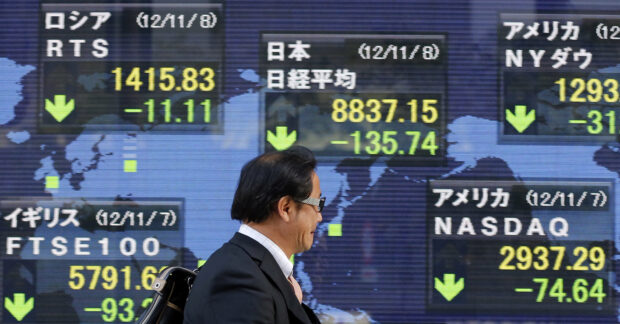
A man passes an electronic board displaying falls in global market indices outside a brokerage in Tokyo Nov 8, 2012. REUTERS/Yuriko Nakao/file photo
SYDNEY – Asian shares hit a three-month peak on Friday as sharp declines in the dollar and U.S. yields extended the Fed-fueled rally, but pushback on rate cuts from central banks in Europe may deal a blow to the global pivot hopes.
MSCI’s broadest index of Asia-Pacific shares outside Japan rose 0.7 percent to the highest since early September and was up 2.5 percent for the week. Japan’s Nikkei jumped 1.2 percent, also heading for a weekly gain of 2.5 percent.
Battered Chinese bluechips rose 0.7 percent to pull away from a five-year low, while Hong Kong’s Hang Seng index rallied 1.7 percent.
China’s central bank on Friday boosted liquidity injections but kept the interest rate unchanged when rolling over maturing medium-term policy loans, matching expectations.
READ: China central bank boosts liquidity injection via policy loan; rate unchanged
Investors are awaiting a slew of Chinese economic data to see if the slowdown in the world’s second largest economy has further to run.
“Everyone is popping the corks now and celebrating that we’ve got the Fed pivot. But the Fed pivot happened two months ago… It has now got to the point where I think you need to be a little bit careful,” said Tony Sycamore, analyst at IG.
“I think rate cuts are priced in a little bit too generously. I wouldn’t be surprised if it would be pushed back to maybe May or June more towards the middle of the year in terms of the first cut and only four cuts.”
On Wall Street, the Dow Jones climbed to a fresh all-time high and the S&P 500 and Nasdaq made new 2023 highs, as markets wagered on a total of 150 basis points in easing expectations – equivalent of six cuts – for the Fed next year.
READ: Bank stocks rally to pre-crisis levels after Fed meeting
Overnight, a host of Europe’s central banks stuck to plans to keep policy tight well into next year, dashing any hope that the Fed’s pivot towards rate cuts marked a global turning point.
The European Central Bank said policy easing was not even brought up in a two-day meeting, the Bank of England said rates would remain high for “an extended period,” and Norway’s central bank even hiked rates.
The euro jumped 1.1 percent overnight and the sterling surged 1.2 percent before holding mostly steady in Asia on Friday. That helped pressure an already frail U.S. dollar, which is down 1.9 percent for the week and hovered near a four-month low at 102.03 against its major peers.
British bond yields and retraced steep falls on Thursday and Germany’s 10-year bond yield bounced off session lows. Treasuries are, however, still heading for the best week in over a year, with the benchmark 10-year yields down a whopping 30 basis points to below 4 percent for the first time since July.
Data also showed U.S. retail sales unexpectedly rebounded in November and jobless claims dipped, suggesting the economy is still too strong to justify the kind of rate cuts baked in next year, but markets were too jubilant to see that.
Treasuries trimmed some of the stellar gains on Friday, with the 10-year yields up 3 basis points to 3.9562 percent. On a weekly basis, they are down 29 basis points. Two-year yields also rose 2 bps to 4.4217 percent, down 30 bps for the week.
READ: Oil prices on track for first weekly rise in two months
Oil prices extended their rally on Friday in opposition to the soft dollar after the International Energy Agency (IEA) lifted its oil demand forecast for next year.
U.S. crude rose 0.3 percent to $71.57 per barrel, after surging more than 3 percent, while Brent was also up 0.3 percent to $76.83 per barrel.
Spot gold slipped 0.1% to $2,033.49 an ounce.

